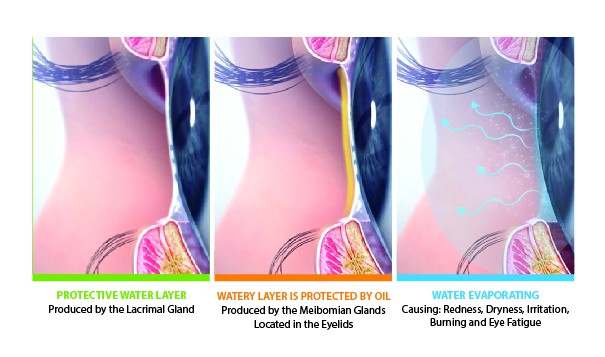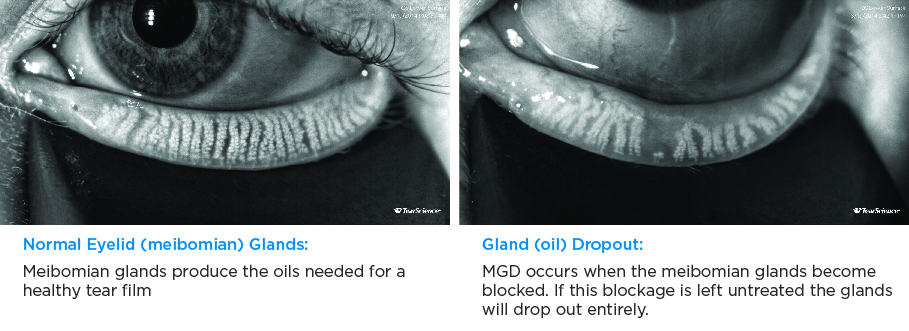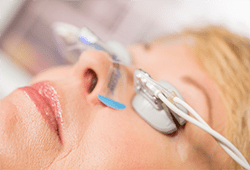Looking for dry eye treatment in Wyomissing? Dry eye related discomfort is an increasingly common complaint of patients. A recent online poll revealed that nearly half of American over 18 regularly experience dry eye symptoms. Dry eyes affect nearly twice as many women as men. There are roughly 30 million people in the United States and over 300 million worldwide with dry eye.
Dry Eye Symptoms
The symptoms of dry eye are varied. The list below is not all inclusive, however patients that suffer from dry eye usually experience a number of the following symptoms:
- Blurry Vision
- Redness
- Burning
- Itching
- Light sensitivity
- Excessive Tearing/watery eyes
- Tired eyes/eye fatigue
- Stringy mucous in and around the eyes
- Foreign body sensation
- Contact lens discomfort
- Scratchy, feeling of sand or grit in eye
What Causes Dry Eye Syndrome?
Dry eye syndrome is caused by a chronic lack of sufficient lubrication and moisture on the surface of the eye. Depending on its cause and severity, it may not be completely curable. In most cases, dry eyes can be managed successfully, usually resulting in noticeably greater eye comfort, fewer dry eye symptoms, and often sharper vision.
Tears on the surface of the eye are essential to keep your eyes healthy, comfortable and seeing well. A normal tear film consists of three important components:
- An outer oily (lipid) component produced by meibomian glands in the eyelids
- A middle watery (aqueous) component produced by lacrimal glands located behind the outer aspect of the upper eyelids
- An inner mucous-like (mucin) component is produced by goblet cells in the conjunctiva

A problem with any of these sources of tear film components can result in tear instability and dry eyes, and there are different categories of dry eyes, depending on which component is affected. If the meibomian glands don’t produce or secrete enough oil, the tear film may evaporate too quickly — a condition called “evaporative dry eye.” The meibomian glands are located along the margin of the eyelids near the base of the eyelashes. These openings can get clogged and as a result the oil that is critical to keeping the tear film from evaporating too quickly cannot do its job. The underlying condition — called Meibomian gland dysfunction or MGD is the root cause of 86% of the cases of dry eye. MGD is a progressive disease that can worsen over time if left untreated. If the obstructed Meibomian glands remain untreated, this can lead to permanent shortening and eventually loss of the glands. Once gland loss has set in it is unlikely to be reversible, so finding and treating MGD early is best.
In addition to evaporative dry eye, MGD is also associated with an eyelid problem called blepharitis.
In other cases of dry eye syndrome, the primary cause may be a failure of the lacrimal glands to produce enough watery fluid to keep the eyes adequately moistened. This condition is called “aqueous deficiency dry eye.” Some oral medications can also cause ocular dryness, and hormonal changes can also contribute to insufficient and poor quality tears.
The specific type of dry eye often will determine the type of treatment your Berks Eye Physicians and Surgeons doctor recommends to give you relief from your dry eye symptoms.
Testing for Dry Eye Syndrome
Knowing what is causing your Dry Eye will help your Berks Eye doctor determine the best treatment option. Your doctor may perform some or all of the following testing.
Osmolarity Testing
Takes a sample of your tears to assess quality. It provide a quick and simple method for determining tear osmolarity (saltiness of your tears) using nanoliter (nL) volumes of tear fluid collected directly from the eyelid to aid in the diagnosis of dry eye disease
Inflammadry Testing
Detects MMP-9, an inflammatory marker that is consistently elevated in the tears of patients with dry eye disease. Using direct sampling microfiltration technology, InflammaDry® accurately identifies elevated levels of MMP-9 protein in tear fluid samples taken from the inside lining of the lower eyelid, the palpebral conjunctiva.
Lipiview Testing
Berks Eye has the latest technology to view and evaluate the structure of the meibomian glands. We use the LipiView® II Ocular Surface Interferometer with DMI to capture detailed images of the meibomian glands and tear film lipid layer.

Meibomian Gland Evaluation
Your Berks Eye doctor may manually or with the help of a Meibomian Gland Evaluator assess whether your glands are excreting any oil.
Treatment Options for Dry Eye Syndrome
Your Berks Eye doctor may recommend one or a combination of several of these dry eye treatment options:
Artificial Tears
Artificial tears containing active ingredients such as carboxymethylcellulose, hydroxypropyl methylcellulose, glycerin, castor oil, polyethyline glycol or polyvinyl alcohol are used in mild cases of dry eyes. Not all artificial tear brands work the same or work in all patients. More severe cases require additional treatment. If you find yourself using your artificial tears three or more times a day you should use a preservative free tear. Most patients find that artificial tears do help, however the affect is only temporary, lasting only 10-15 minutes. Most of these patients will experience significant relief with punctal occlusion.
Prescription Eye Drops
Instead of or in addition to over-the-counter artificial tears, your Berks Eye doctor might recommend daily use of prescription eye drops. Prescription eye drops reduce inflammation associated with dry eye syndrome and help produce more natural tears to keep your eyes moist, comfortable and healthy. Your doctor may also prescribe temporary steroid drops to better manage the underlying inflammation associated with dry eyes. Steroid eye drops are generally used short-term to quickly manage symptoms. They are often used in conjunction with artificial tears as a complement to these more long-term treatment strategies.
Eye Lubricant Gels & Ointments
Your doctor may also recommend a preservative-free lubricating agent (hydroxypropyl cellulose) that slowly liquefies over time, providing an all-day moistening effect. This typically is recommended for patients with moderate to severe dry eye symptoms, especially if dry eye treatment with artificial tears alone proves unsuccessful.
Nutritional Supplements
Our doctors sometimes recommend omega-3s supplements made with high quality fish to decrease dry eye symptoms. It is available in pill and liquid form.
Thermal (Heat) Therapy (Warm Compresses)
Many people utilize a warm heat mask to help open clogged meibomian glands. This easy and convenient at home application of moist heat often provides soothing relief to dry eyes.
Eyelid Scrubs or Cleaners
There are several over the counter and prescription cleaning products that are recommended to Berks Eye patients for removal of bacteria and irritants.
Punctal Plugs
The puncta is the small opening found on the edge of the upper and lower eyelids next to the nose. Tears drain out of the eye through the puncta into the nose, this is why your nose runs when you cry. If you aren’t producing enough tears then you don’t want the tears that you are producing to be drained away. Punctal occlusion is painless and performed in the office, taking only a couple of minutes.
Meibomian Gland Expression
To treat MGD and evaporative dry eye, your eye doctor may perform an in-office procedure called meibomian gland expression. In this procedure, warm compresses may or may not first be applied to your eyelids; then a forceps-type device is used to squeeze the clogged contents (hardened meibum and possibly other substances) from the meibomian glands. To fully express the contents of the meibomian glands and get them functioning properly, significant pressure must be applied to the eyelids, which can be uncomfortable. But the results usually are worth putting up with the short-term discomfort of the procedure.
LipiFlow®
 The LipiFlow Thermal Pulsation System (TearScience) is an automated, in-office dry eye treatment that combines the best features of warm compress therapy and meibomian gland expression. The patented device fits onto the eye and also over the eyelids and applies precisely controlled heat to the lids to soften hardened meibum. At the same time, the LipiFlow system applies pulsed pressure to the eyelids to open and express clogged meibomian glands, thereby restoring the correct balance of oils in the tear film to relieve dry eye syndrome. Lipiflow treatment takes approximately 12 minutes per eye. In a clinical study of the effectiveness of the procedure, most patients (76 percent) reported improvement of their dry eye symptoms within two weeks, and patients also showed improvement in the quality and quantity of meibomian gland secretions and the duration of time their tear film remained on the eye before evaporating. In some cases, however, it can take a few months for improvements to become apparent.
The LipiFlow Thermal Pulsation System (TearScience) is an automated, in-office dry eye treatment that combines the best features of warm compress therapy and meibomian gland expression. The patented device fits onto the eye and also over the eyelids and applies precisely controlled heat to the lids to soften hardened meibum. At the same time, the LipiFlow system applies pulsed pressure to the eyelids to open and express clogged meibomian glands, thereby restoring the correct balance of oils in the tear film to relieve dry eye syndrome. Lipiflow treatment takes approximately 12 minutes per eye. In a clinical study of the effectiveness of the procedure, most patients (76 percent) reported improvement of their dry eye symptoms within two weeks, and patients also showed improvement in the quality and quantity of meibomian gland secretions and the duration of time their tear film remained on the eye before evaporating. In some cases, however, it can take a few months for improvements to become apparent.
Autologous Serum Eye Drops
Eye drops derived from a patient’s own blood help many dry-eye patients live better lives. The patient donates blood; the blood coagulates and is centrifuged to extract the serum; and a quantity of serum is placed into a dropper bottle, usually with diluent—often a sterile saline solution.
Other
Other techniques to reduce dry eye symptoms include blinking more frequently, taking breaks while using electronic devices, drinking more water, warm compresses and wearing sunglasses with wrap around to reduce the wind, dust and other irritants that can worsen dry eye symptoms.
 1802 Paper Mill Road, Wyomissing, PA 19610
1802 Paper Mill Road, Wyomissing, PA 19610

